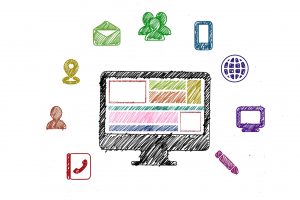30 Strategy: Email Correspondence
Strategy: Email Correspondence

Email Basics
E-MAIL
Electronic mail, usually called e-mail, is quite familiar to most students and workers. It may be used like text, or synchronous chat, and it can be delivered to a cell phone. In business, it has largely replaced print hard copy letters for external (outside the company) correspondence, as well as taking the place of memos for internal (within the company) communication (Guffey, 2008). E-mail can be very useful for messages that have slightly more content than a text message, but it is still best used for fairly brief messages.
Many businesses use automated e-mails to acknowledge communications from the public, or to remind associates that periodic reports or payments are due. You may also be assigned to “populate” a form e-mail in which standard paragraphs are used but you choose from a menu of sentences to make the wording suitable for a particular transaction.
E-mails may be informal in personal contexts, but business communication requires attention to detail, awareness that your e-mail reflects you and your company, and a professional tone so that it may be forwarded to any third party if needed. E-mail often serves to exchange information within organizations. Although e-mail may have an informal feel, remember that when used for business, it needs to convey professionalism and respect. Never write or send anything that you wouldn’t want read in public or in front of your company president.
TIPS FOR EFFECTIVE BUSINESS E-MAILS
- Proper salutations should demonstrate respect and avoid mix-ups in case a message is accidentally sent to the wrong recipient. For example, use a salutation like “Dear Ms. X” (external) or “Hi Barry” (internal).
- Subject lines should be clear, brief, and specific. This helps the recipient understand the essence of the message. For example, “Proposal attached” or “Your question of 10/25.”
- Close with a signature. Identify yourself by creating a signature block that automatically contains your name and business contact information.
- Avoid abbreviations. An e-mail is not a text message, and the audience may not find your wit cause to ROTFLOL (roll on the floor laughing out loud).
- Be brief. Omit unnecessary words.
- Use a good format. Include line breaks between sentences or divide your message into brief paragraphs for ease of reading. A good e-mail should get to the point and conclude in three small paragraphs or less.
- Reread, revise, and review. Catch and correct spelling and grammar mistakes before you press “send.” It will take more time and effort to undo the problems caused by a hasty, poorly written e-mail than to get it right the first time.
- Reply promptly. Watch out for an emotional response—never reply in anger—but make a habit of replying to all e-mails within twenty-four hours, even if only to say that you will provide the requested information in forty-eight or seventy-two hours.
- Use “Reply All” sparingly. Do not send your reply to everyone who received the initial e-mail unless your message absolutely needs to be read by the entire group.
- Avoid using all caps. Capital letters are used on the Internet to communicate emphatic emotion or yelling and are considered rude.
- Test links. If you include a link, test it to make sure it is complete.
- E-mail ahead of time if you are going to attach large files (audio and visual files are often quite large) to prevent exceeding the recipient’s mailbox limit or triggering the spam filter.
- Give feedback or follow up. If you don’t get a response in twenty-four hours, e-mail or call. Spam filters may have intercepted your message, so your recipient may never have received it.
Let’s look at two examples of business e-mail. In Figure 13.1, we have an e-mail form. In Figure 13.2, we have a letter written specifically for the situation and audience.
Figure 13.1
Welcome to [company name].
Dear [customer’s name],
Thank you for registering with the [company name].
You can manage your personal information from the “My Account” section of the site when you sign in to [company name].
You can change your contact details and password, track recent orders, add alternate shipping addresses, and manage your preferences and customer profile all in this one convenient location.
Thank you for your interest in [company name].
We look forward to your next visit.
Figure 13.2
To: Harriet Adamo, Physical Plant Manager, XYZ Corporation
From: Mel Vargas, Construction Site Manager, Maxim Construction Company
Sent: Monday 10/25/09 8:14 AM
Subject: construction interruptions
Harriet,
I know employees of XYZ Corp. are looking forward to moving into the new ABC Street building in January, but recently groups of employees who do not have business here have been walking through the building. These visits create a safety hazard, interrupt the construction workers, and could put your occupancy date in jeopardy.
Would you please instruct your staff members who haven’t already been moved to ABC Street to stay out of the building? If they need to meet here with someone who has already moved, they should conduct their business and leave promptly via the nearest staircase.
We need to avoid further interruptions so our construction workers can get the building ready for occupancy on schedule. If you have any questions, please call me.
Thanks,
Mel
Melvin R. Vargas
Construction Site Manager, Maxim Construction Co.
1234 Main Street, Big City, USA 98765-1111
(111) 123-4567, ext. 89
Built-In Practice: Email Correspondence
